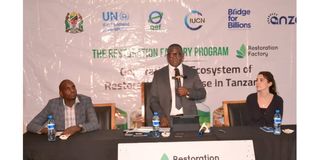How Tanzania’s green future project aims to restore forests, boost biodiversity

The Sustainable Environmental Restoration and Biodiversity Conservation project coordinator from the Vice President’s Office, Dr Damas Mapunda, delivers remarks during the graduation and business presentation event for entrepreneurs participating in the Restoration Factory Programme in Iringa on Friday, March 28, 2025. PHOTO| Friday SIMBAYA
What you need to know:
- The initiative is part of the global programme "The Restoration Initiative (TRI)", which involves ten countries, including Tanzania, Cameroon, Kenya, Central African Republic, Pakistan, China, Democratic Republic of the Congo, and Guinea-Bissau.
Iringa. Tanzania is implementing the Sustainable Environmental Restoration and Biodiversity Conservation Project to support the national target to restore five million hectares of degraded forests and land.
The initiative is part of the global programme "The Restoration Initiative (TRI)", which involves ten countries, including Tanzania, Cameroon, Kenya, Central African Republic, Pakistan, China, Democratic Republic of the Congo, and Guinea-Bissau.
Through the project, Tanzania contributes to restoration efforts for degraded land, a commitment first announced in 2018.
The project coordinator from the Vice President’s Office, Dr Damas Mapunda, said on March 28, 2025, during the graduation and business presentation event for entrepreneurs under the restoration factory programme in Iringa, that the project is crucial in supporting national restoration targets of 5.2 million hectares of degraded forests and land.
“The Vice President’s Office in collaboration with the United Nations Environment Programme (UNEP), the International Union for Conservation of Nature (IUCN), and seven district councils jointly implement this project,” said Dr Mapunda.
A grant of $11.21 million from the Global Environment Facility (GEF) has been disbursed from 2021 to 2025 to fund the project.
Its primary goal is to strengthen integrated environmental management and restore degraded ecosystems, thereby enhancing ecological resilience and improving community well-being across Tanzania.
The initiative focuses on the Great Ruaha Basin and Lake Rukwa Basin, covering the districts of Iringa, Mbarali, Wanging’ombe, Mbeya, Sumbawanga, Mpimbwe, and Tanganyika.
The project aims to restore 110,000 hectares of degraded land and reduce carbon emissions by 4.7 million tonnes by 2025.
Private sector participation
The government recognises the private sector as a key player in environmental restoration, particularly in mobilizing financial resources, expertise, and technology.
However, private sector involvement remains low due to limited awareness of the restoration economy, a lack of commercially viable restoration projects, and insufficient incentives for investment in the sector.
To address this, the Sustainable Environmental Restoration and Biodiversity Conservation (SLR) Project, through Bridge for Billions (B4B) and Anza Entrepreneurs, is implementing The Restoration Factory Programme.
Dr Mapunda acknowledged the contribution of stakeholders, stating: “I would like to take this opportunity to recognize the support from UNEP, IUCN, Bridge for Billions, and Anza in making the Restoration Factory Programme a success.”
Achievements of the incubation programme
According to IUCN, the programme was established to empower entrepreneurs to develop environmentally sustainable businesses, helping to achieve restoration, biodiversity conservation, and climate resilience goals.
IUCN project advisor Mr Doyi Mazendele highlighted that the programme aims to engage businesses and investors in the environmental sector for economic benefits.
A total of 46 entrepreneurs enrolled in the programme, with 31 graduating, equivalent to a 68 percent completion rate.
Additionally, 36 business mentors participated, but only 14 completed the training.
Entrepreneurs' testimonies
The founder and director of Nishati Eco Biomass Briquettes located in Tegeta-Nyuki, Dar es Salaam, Ms Annet Mutembei, emphasised the role of alternative charcoal made from agricultural waste such as wood shavings and groundnut shells in reducing deforestation.
“Ninety percent of Tanzanians rely on charcoal and firewood, sourced from forests. The production of alternative charcoal will help curb deforestation, combat climate change, and reduce global warming,” said Ms Mutembei.
She added that eco-friendly charcoal is more affordable and improves health conditions for women who traditionally use firewood, and smoky charcoal contributes to respiratory diseases.
KPLT CO. Ltd in Visiga, Coast Region Director, Mr Deogratius Kapalata, which produces Virgin Coconut Oil and Biomass Briquettes from coconut husks and agricultural waste, noted that smoke-free briquettes are environmentally friendly.
He also highlighted that using coconut husks as raw material helps to eliminate mosquito breeding grounds, thereby reducing malaria infections.
This project is expected to significantly impact environmental restoration, biodiversity conservation, and private sector involvement, promoting sustainable development in Tanzania.





